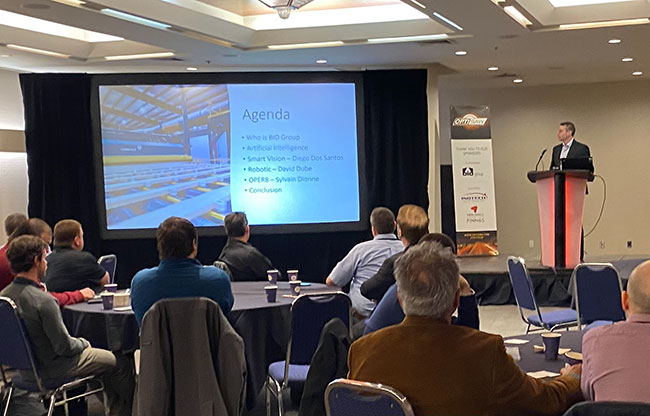
Features
Equipment
Maintenance
Mills
Sawmilling
OptiSaw 2023: Cutting edge of saw milling tech and processes
March 17, 2023 By Jennifer Ellson
 The BID Group opened the event with a peek into the sawmill of the future. Photo: Annex Business Media.
The BID Group opened the event with a peek into the sawmill of the future. Photo: Annex Business Media. The global pandemic, economic crunch, and inflation have forever altered the already transitioning forest industy. In this ever-changing environment and the pressure to do more with less, what’s a sawmiller to do?
Researchers and innovative manufacturers offered valuable insight into the cutting edge of sawmilling technologies and processes, and shared strategies to optimize production and boost mill’s profits at OptiSaw – the sawmilling optimization and automation forum – in Quebec City on March 17.
Sawmill of the future
The BID Group opened the event with a peek into the sawmill of the future powered by a combination of cutting-edge technologies and an inspired workforce. The company is leading the way in several areas related to Industry 4.0: IIoT, augmented reality, robotics, artificial intelligence, and designing the next generation of sawmills.
BID’s Diego Braido dos Santos, David Dubé, and Sylvain Dionne showed the crowd of 50 delegates and exhibitors some of BID’s innovative technologies, including AI and robotics and their individual impact on operations such as monitoring and optimizing process flow in sawmills and planer mills.
Smart eyes: reinforcing scanners with AI
The next presenter, Finnos Oy’s Jyri Smagin walked the audience through the sawmill’s different scanners at various locations, showing how the latest technology enables the scanners to connect with each other via fingerprint technology. Smagin demonstrated how applying AI optimization to the whole raw material flow linked by fingerprint can detect defects, and increase fibre recovery and yield significantly.
Energy transition
Experts agree, the energy transition in the industrial sector must be achieved by 2050. Incentives are available to initiate the transition, offered by energy suppliers or governments, but where can one start a project? Martin Tremblay of IDÉA Contrôle, an internationally recognized energy management equipment manufacturer, shared their efficient and effective tools to simplify the energy transition, which can reduce sawmill emissions and costs.
Jedi, Big Data and IoT
The next speaker, Tim Melburn of Arrow Speed Controls, a self-described Jedi-level asset performance engineer, helped attendees visualize the invisible by showing how to increase productivity with cutting-edge technologies.
Optimizing machine productivity and maintaining a competitive edge can become increasingly difficult in a global economy, but Big Data and IoT technologies offer a wide variety of potential improvements from production efficiency to predicting machine failures to managing employees.
“Have you ever wondered how to get the most out of your equipment while ensuring they run at optimal performance? Having the right KPIs and a solid preventative maintenance plan will provide incredible cost savings,” Melburn said.
Cutting downtime in halF
The first of two case studies presented at OptiSaw was a planer safety pilot project, given by UBSafe’s Ian Rood.
UBSafe performed a functional safety system upgrade to a Stetson Ross planer at Conifex Fort St. James in B.C. To utilize the safeguarding system for minor servicing tasks, such as clearing jams, the WorkSafeBC approval process under regulation 10.10 for control system isolation device (CSID) use as an alternative control measure to lockout was triggered. Rood detailed the results of the project – a safe, compliant, efficient system that was measured to reduce jam clearing-related downtime by 50 per cent.
Sawmill simulation
FPInnovations’ Mohammed Khachan provided an overview of the new software platform OptiTek, including drying and planing simulation, profit evaluation and flow analysis. Khachan said the platform allows stakeholders in the sawmill ecosystem to validate, analyze, and measure the impact on key performance indicators of new technologies and processes. His two-part presentation included an introduction of AI into the simulation process and its interest in estimating the value of stems supply from the forest to the mill.
Optimizing value chain
Maximizing a mill’s efficiency with unique CT technology and the power of prediction and optimization were the focus of the next speaker, Microtec’s Patrick Freeman, who went into thorough detail to describe the Microtec AI platform. Utilizing these tools, along with the innovative SMART Link solution, companies are able to streamline and optimize each stage of your value chain to drive maximum value, said the CTO, who described himself as the ‘chief nerd’ in a room full of nerds.
Case study on drying
Secovac founder Pierre Gilbert was the final speaker, and presented the second case study and “the most important presentation of the day,” he joked. Gilbert shared results of the installation of the EchoStop system, Secovac’s latest technological breakthrough in the field of drying control, at Clermond Hamel’s sawmill in Quebec.
EchoStop was designed to measure wood moisture without contact for continuous kilns. It has optimized the sawmill’s operations, eliminated the down grade caused by overdrying, increased production and reduced the energy required.
Print this page